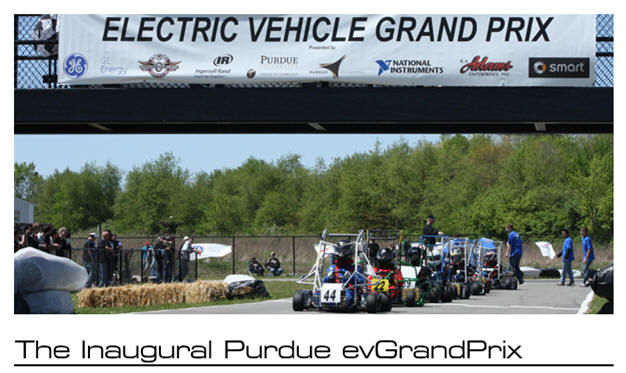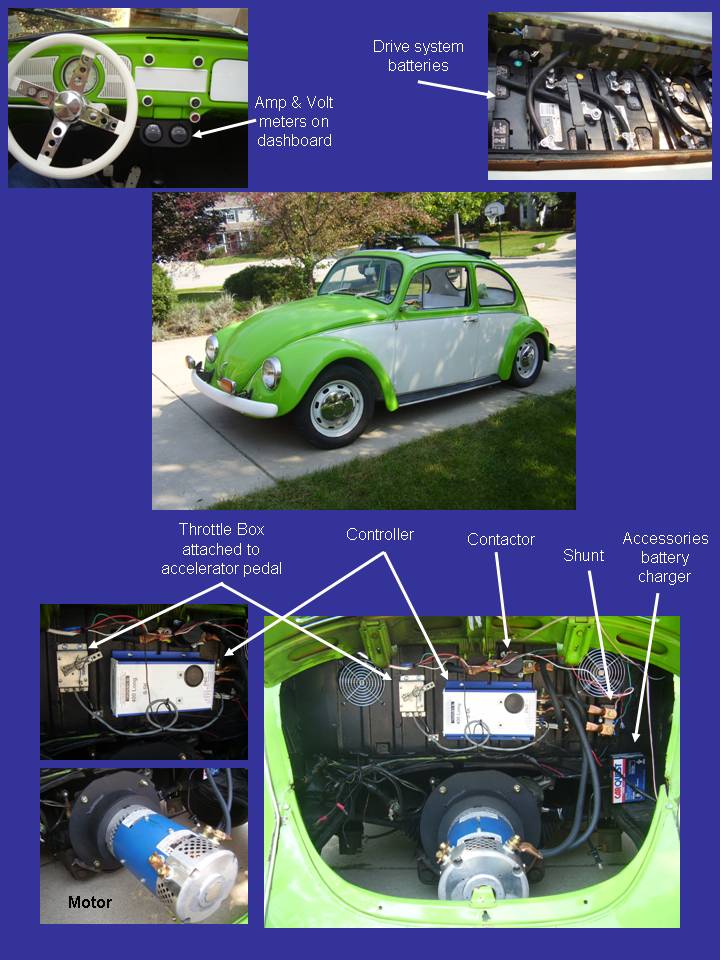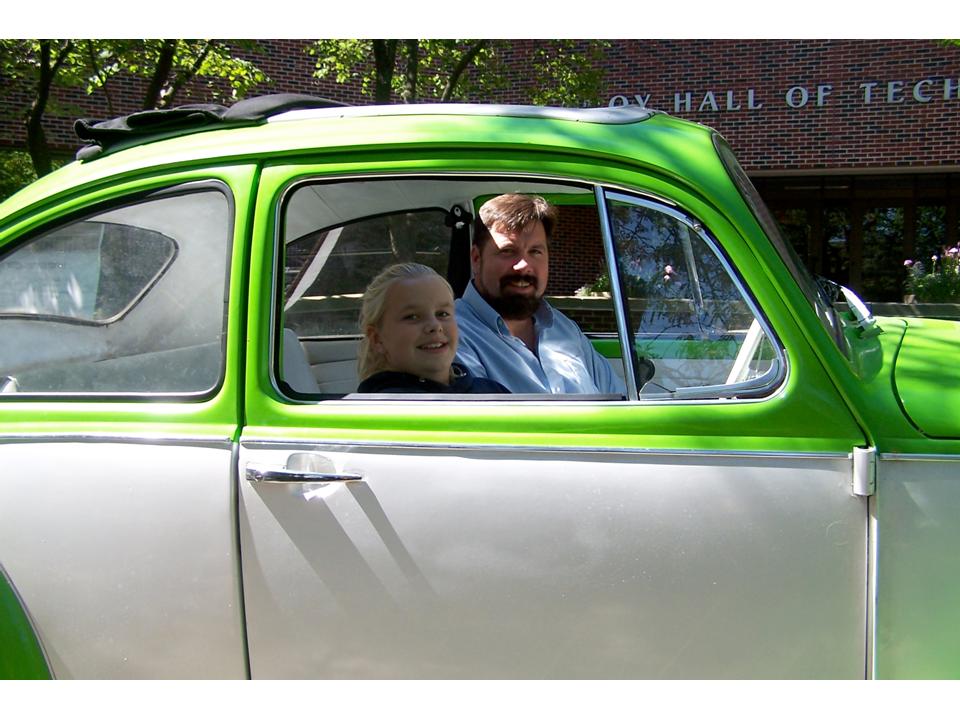This web site is dedicated to the
development of automotive vehicles
that run purely on electric power...


College of Technology - Purdue University
This web site is dedicated to the
development of automotive vehicles
that run purely on electric power...


College of Technology - Purdue University
Michael D. Kane, PhD
Department of Computer and Information Technology
Purdue University - West Lafayette, Indiana 47907
First Go-Kart EV Project (Spring 2010) - KART #44 in the inaugural EVGrand Prix!
The Department of Computer and Information Technology is sponsoring an EV Go-Kart for the first annual EV Grand Prix scheduled for April 18, 2010 at Purdue University. The kart is equipped with 5 x 12v AGM Optima batteries, an Alltrax 7234 controller and a D&D ES-15A motor.

NEWS: The Bug meets the TESLA!!!
First Street Legal EV Conversion: 1973 VW Bug
The first project was funded/completed by Professor Michael Kane and involves a 1973 Volkswagen Beetle. The VW cost was $1,500 (without the engine) and had already been renovated (interior and exterior, looks great!). The conversion involved adding a 12-hp* DC motor to the existing VW transmission, as well as a dedicated potentiometer (i.e. throttle box), controller, contactor, shunt, and batteries (deep-cycle marine/RV batteries). Note that the design of this EV was aimed at a "low cost" conversion rather than "high performance", and there are many different components and configurations that allow you to best balance cost-to-performance.
*Determining horsepower on an electric motor is different than a gas engine. Key electric system variables include the system voltage (I am using 72 volts, or six 12-volt batteries in series), overall amps, motor specs, etc. In addition, electric motor hp and gas engine hp are simply calculated differently. In terms of common estimations of vehicle horse power, this system is equivalent to about a 30hp gas engine (NOTE: The original air-cooled engine in this 1973 VW was about 50hp).
Here's how it works...
Turning the ignition key to the "on" position sends a small 12v current (from the accessories battery, also used for headlights & brake lights) to the Contactor, which is a relay that "closes" the drive system circuit (basically, flipping the switch for the motor to "ON"). At this point the car is "on" (although there is no noise). Pressing down on the accelerator pedal pulls the arm on the Throttle Box, which works like a "volume knob" on your stereo, and the Controller interprets this "increase in volume" as a command to send more electricity to the DC motor... and the car moves down the road. The Controller's job is to translate the signal from the potentiometer (Throttle Box) to the amount of amps sent to the drive Motor, and it shouldn't be too surprising to learn that every electric golf cart has a similar controller onboard. Since the motor is connected directly to the existing transmission, different gears can be used (including reverse). However it should be noted that due to the tremendous torque the DC motor generates at low RPMs (compared to an internal combustion engine), I can simply leave the vehicle in 3rd gear and drive around town (i.e. no shifting, the clutch is disabled). The Shunt is used to connect the amp meter allowing the driver to monitor the system's performance. In simple terms, the amp meter is somewhat equivalent to a tachometer and tells you how much electric power the motor is using, while the volt meter acts as the fuel gauge and tells you how much electrical energy remains in the drive system batteries.

UPDATE 2010: The drive system batteries are charged using an automatic 72V (10 amp) battery charger (which was added in 2010 to replace the external manual battery charger) plugged into a common 110v electric outlet (above and left of the motor in the picture below), which displays the percent charge of the system and automatically shuts-off at 100%. Note that the small air compressor mounted above the motor (pictured below) has been added simply to provide occasional pressure to the air-shock absorbers on the rear axle. Please note that this web site is NOT attempting to endorse any particular product or vehicle configuration. The overall goal of this EV project is to find the optimal balance between safety, performance and cost.
Why is the VW Bug a great car for a conversion?
1) It is a simple, light-weight vehicle.
2) It has no power steering, no power brakes, and a manual transmission.
3) It has a "tow bar" attachment that allows it to be towed by a trailer hitch in the event that it looses all battery power.
NOTE: I found my VW on www.thesamba.com.
Spreading the word on Electric Vehicles...
Professor Kane introduces the EV to students in the Business School at Purdue
University.
Professor Kane introduces the EV to young students in a local
elementary school.
In The News...
Journal & Courier article (local paper, Lafayette, Indiana)
Exponent article (Purdue's campus paper)
College of Technology NewsLetter

Displaying the vehicle during "Green week" in front of Knoy Hall of Technology at Purdue University with my daughter.
Fall 2010: New Course - Introduction to Electric Vehicle Technology
The picture below shows students examining the different components of vehicles in our new EV course, which includes the EV bug (green), a Tesla Roadster (red), an electric go kart, a street-legal electric golf cart, and an electric motor cycle...
The Electric Bug meets the TESLA!!!
For more info CONTACT:
Michael D. Kane, PhD
Associate Professor, Department of Computer and Information Technology
College of Technology, Purdue University
email: mdkane "at" purdue.edu
Professor Kane's expertise is in Biomedical Informatics, and he also likes building (and playing) electric guitars as part of the Purdue Guitar Workshop, check 'em out...
